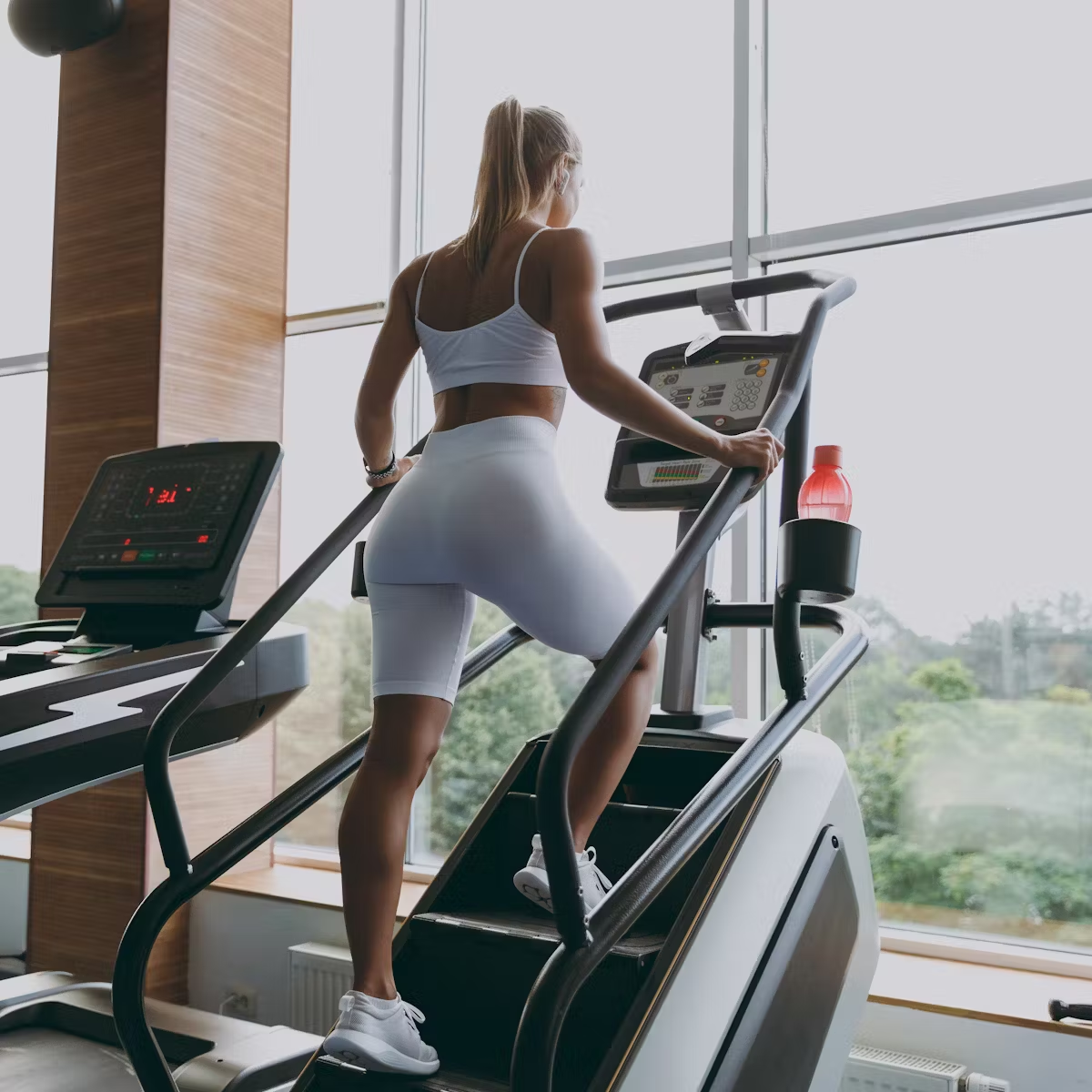Remember that one time I decided to shake up my routine after scrolling through TikTok late at night? I stumbled on this viral challenge that promised killer cardio without the joint-jarring impact of running. Yeah, that’s how I first met the 25-7-2 StairMaster workout. It’s simple on paper but packs a punch in practice, and honestly, it left me huffing like I’d just chased my dog up a hill. If you’re curious about this trend that’s buzzing everywhere from gym floors to social feeds, stick around. We’ll break it down, weigh the ups and downs, and figure out if it’s worth lacing up for.
What Exactly Is the 25-7-2 StairMaster Workout?
At its core, this routine is straightforward cardio bliss—or torture, depending on your fitness level. You hop on a StairMaster machine, set it to level 7, and climb steadily for 25 minutes straight. Repeat that twice a week, and voilà, you’re in the club. No fancy intervals, no equipment swaps—just you, the endless stairs, and maybe a killer playlist to drown out the burn.
The magic lies in its simplicity. Level 7 is that sweet spot where it’s challenging but sustainable for most folks, pushing your heart rate up without maxing out too soon. It’s all about steady-state cardio, where you’re working hard enough to sweat buckets but can still chat (or sing along) if you must. Think of it as the StairMaster’s answer to a brisk hike, minus the scenic views.
The Origins of the Trend
This workout didn’t just appear out of thin air—it exploded on TikTok thanks to creator @shutupcamilla, who shared it as her go-to for prepping for a pageant. She claimed it helped sculpt abs and torch fat, and suddenly, everyone from fitness newbies to gym rats was trying it. Videos racked up millions of views, with folks documenting their sweat-drenched sessions and before-and-after glow-ups.
What started as a personal hack quickly snowballed into a cultural thing, much like the 12-3-30 treadmill walk before it. It’s that perfect mix of accessible and aspirational—anyone with gym access can try it, but finishing strong feels like a win. Plus, in a world of complicated HIIT routines, its no-frills vibe is refreshingly real.
Key Benefits of the 25-7-2 Workout
Why bother with endless stairs when you could just jog? Well, this routine shines in a few key areas that make it stand out for busy people chasing results.
- Heart Health Hero: It ramps up your cardiovascular endurance, lowering resting blood pressure and reducing heart disease risks over time.
- Calorie Crusher: Expect to burn around 200-300 calories in one session, depending on your weight and intensity—great for weight management without high impact.
- Lower Body Toner: Targets quads, glutes, hamstrings, and calves, building strength and definition with each step.
- Low-Impact Love: Easier on knees and hips than running, making it ideal for joint-friendly fitness.
- Mental Boost: That endorphin rush post-climb? It’s real, helping melt stress and sharpen focus.
I’ve seen friends swear by it for that quick energy lift on hectic days—it’s like therapy with a side of sweat.
Potential Drawbacks and Considerations
Not everything’s uphill glory, though. This workout isn’t a one-size-fits-all miracle, and overlooking its limits could lead to frustration or worse.
- Limited Muscle Building: It’s cardio-focused, so don’t expect massive gains like from weights—pair it with strength training for balance.
- Monotony Factor: Staring at the same machine twice weekly? Boring for some; spice it up with podcasts or friends.
- Overuse Risk: Too much too soon might strain calves or knees, especially if form slips.
- Not for Everyone: Folks with hip, knee, or balance issues should skip or modify—chat with a doc first.
- Plateau Potential: Without progression, results stall; up the level or time as you adapt.
I remember pushing through one session only to feel my shins complain the next day—lesson learned on listening to your body.
How to Perform the 25-7-2 Workout Safely
Ready to step up? Here’s your step-by-step guide to nailing it without mishaps. Start with a warm-up: 5 minutes at level 3-4 to get blood flowing.
- Hop on the StairMaster and set to level 7—adjust if needed for your machine (levels vary slightly by model).
- Maintain upright posture: Core engaged, shoulders back, light grip on rails for balance only.
- Climb steadily for 25 minutes—no stopping, but sip water as needed.
- Cool down with 2-3 minutes at a lower level, then stretch your legs.
- Repeat twice weekly, on non-consecutive days for recovery.
Pro tip: Push through heels for better glute activation, and breathe deeply to avoid dizziness. If you’re new, film your form to check posture—it’s a game-changer.
Modifications for Different Fitness Levels
Not at level 7 yet? Or craving more challenge? Tailor it to fit you. Here’s a quick breakdown:
| Level | Time | Intensity | Best For |
|---|---|---|---|
| Beginner | 10-15 min | Level 4-5 | Newbies building stamina |
| Intermediate | 25 min | Level 6-7 | Steady progress seekers |
| Advanced | 30+ min | Level 8+ with intervals | Pros wanting extra burn |
For variety, add arm swings (no rails) for core work, or reverse steps for hamstring focus. If no StairMaster, use actual stairs—aim for 200-300 steps per session.
Real-Life Experiences: What Users Are Saying
Diving into social chatter, reactions are mixed but mostly pumped. One TikToker shared, “Sweaty mess after 25 mins, but my legs feel stronger already!” Another on X noted, “Did it daily for a week—exhausting, but noticed better endurance.” A beginner confessed, “Started at level 5; built up slowly—no regrets.”
I tried it myself during a rut, and while the first session had me questioning life, by the second, I felt that addictive post-workout high. Friends echo this: It’s tough but rewarding, with visible toning after a month when combined with diet.
Comparing 25-7-2 to Other Cardio Trends
How does it stack against favorites like the 12-3-30 treadmill walk? Let’s compare for clarity.
| Workout | Duration | Equipment | Focus | Intensity |
|---|---|---|---|---|
| 25-7-2 StairMaster | 25 min, 2x/week | StairMaster | Cardio + lower body | Moderate-high |
| 12-3-30 Treadmill | 30 min, 3-5x/week | Treadmill | Incline walking | Moderate |
| Steady-State Running | 20-40 min | None/outdoors | Endurance | Variable |
| HIIT Cycling | 20 min | Bike | Intervals | High |
The 25-7-2 edges out for low-impact strength, but 12-3-30 wins for accessibility if stairs intimidate. Mix them for variety—your body will thank you.
Where to Get Started: Finding a StairMaster
Gym not your scene? Many chains like Planet Fitness or LA Fitness have them—check apps for locations. Home versions exist too; brands like StairMaster or NordicTrack offer models from $500-$3000. For apps, try Peloton’s digital classes with stair simulations, or free YouTube guides for form tips.
If buying, snag the Bowflex Max Trainer for a hybrid stair-elliptical vibe. Local spots? Community centers often have affordable access—worth a Google.
Best Tools and Gear for Enhancing Your Workout
Amp up sessions with these picks. For tracking, a Fitbit Charge 6 monitors heart rate and steps seamlessly. Grippy shoes like Nike Metcon 9 prevent slips, while wireless earbuds (Apple AirPods Pro) keep motivation flowing.
Recovery tools? A Theragun mini massages sore calves post-climb. For home setups, the X3 Bar system complements with resistance training. Shop Amazon or Dick’s Sporting Goods for deals—start with basics and build.
People Also Ask
Drawn from real searches, here’s what folks wonder most.
Is the 25-7-2 Workout Effective for Weight Loss?
Absolutely, when paired with a calorie deficit—it boosts metabolism and burns fat steadily. One user lost 5 pounds in a month, but results vary.
What Does Level 7 Mean on a StairMaster?
It’s a moderate speed, around 60-70 steps per minute—challenging but not sprint-level. Test your machine; levels aren’t universal.
Can Beginners Try the 25-7-2?
Yes, but scale down: Start at 10 minutes on level 4. Build gradually to avoid burnout.
Does It Really Build Abs?
Indirectly—hands-free climbing engages core for stability, but add planks for definition.
How Many Calories Does It Burn?
Roughly 250-400 per session, based on weight and effort. Track with a fitness app for accuracy.
FAQ
How often should I do the 25-7-2 workout?
Twice a week is the sweet spot for recovery, but listen to your body—don’t overdo it.
Is the StairMaster better than running for cardio?
It depends; StairMaster is lower impact, great for joints, while running builds bone density. Both rock for heart health.
What if I don’t have access to a StairMaster?
Use real stairs or an elliptical—aim for similar intensity. Apps like Nike Training Club have alternatives.
Can this workout help with toning legs?
Definitely; it strengthens quads and glutes effectively. Combine with squats for max results.
Are there risks for people with knee issues?
Yes, the repetitive motion could aggravate—opt for swimming or consult a pro first.
In wrapping up, the 25-7-2 StairMaster workout is a solid pick if you’re after efficient, low-fuss cardio that fits into a packed life. It’s not a magic fix—all, but folded into a balanced routine with eats and rest, it could be your new fave. I gave it a whirl and felt more energized, though my calves begged for mercy at first. Give it a shot, tweak as needed, and see how it climbs into your fitness story. What’s your take—ready to step up?
(Word count: 2,712)



